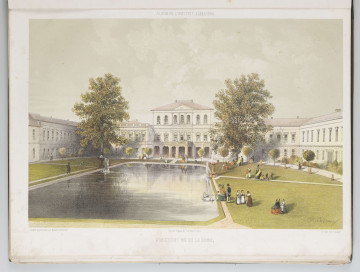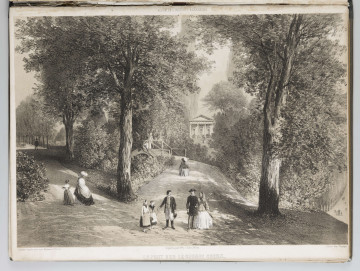
L'Institut vu de la cour
1860
National Museum in Lublin
Part of the collection: Lubliniana. Painting views of Lublin and the Lublin Region (17th–early 20th c.)
The lithograph shows a fragment of a park in Puławy. The romantic English-style garden surrounding the residence was the work of Duchess Izabella Czartoryska. A feature of the English garden, as opposed to the symmetrical French garden, was irregularity, the impression of being shaped by nature. Various buildings, artificial ruins, caves and obelisks were placed among the greenery. In Puławski Park, on the so-called Wild Promenade, a classicist building was erected, referring in its form to Marie Antoinette's Petit Trianon. Completed in 1794, Marynki Palace was a wedding gift from Izabella and Adam Kazimierz Czartoryski to their daughter Maria, married to Louis, the Duke of Württemberg-Montbéliard. The marriage broke up before the building was completed, due to the Duke's shameful betrayal in the war of 1792. After the divorce, by which her only son was taken from her, Maria went to Warsaw. She engaged in literary, cultural and charitable activities. From her pen came the first Polish psychological and moral novel, Malwina, czyli domyślność serca [Malwina, or the Default of the Heart]. The palace, which had just been finished, was plundered by Russian soldiers during the Kościuszko Uprising. In the following years, the family's guests stayed there.
Marynka's palace was immortalized by, among others, Jan Piotr Norblin and Zygmunt Vogel. Cassagne's lithograph shows the building from the rear façade, viewed from the island, the so-called Kępa na Wiśle. Among the picturesque old trees - magnificent poplars, lindens, oaks and maples - the mass of the two-storey façade with an apse in the middle shines white. Cows grazing on Kępa remind us of its former purpose. There was a "holendernia" farm here, where a Dutch family bred pedigree cattle.
The card comes from the lithographic album Album des vues de l'Institut Alexandra du jardin et des environs de Novo Alexandra (Pulawy) published in Paris in 1858. The author of the twenty-four drawing and watercolour prototypes was Barbara Czernof, a drawing teacher at the Alexandria Institute for the Education of Ladies. The Tsarist educational establishment functioned in a property in Puławy, which was confiscated by the Russians after 1831 and renamed New Alexandria by the tsarist authorities. In the 1850s the artist produced many works showing the corners of the Czartoryski family's former residence and views of the surrounding area: Parchatka, Janowiec, Kazimierz.
Bożena Kasperowicz
Author / creator
Dimensions
cały obiekt: height: 30,5 cm, width: 42,2 cm
Object type
graphics
Technique
lithography
Material
cardboard
Creation time / dating
Creation / finding place
Owner
The National Museum in Lublin
Identification number
Location / status

1860
National Museum in Lublin

1860
National Museum in Lublin

1860
National Museum in Lublin
DISCOVER this TOPIC
National Museum in Lublin
DISCOVER this PATH
Educational path